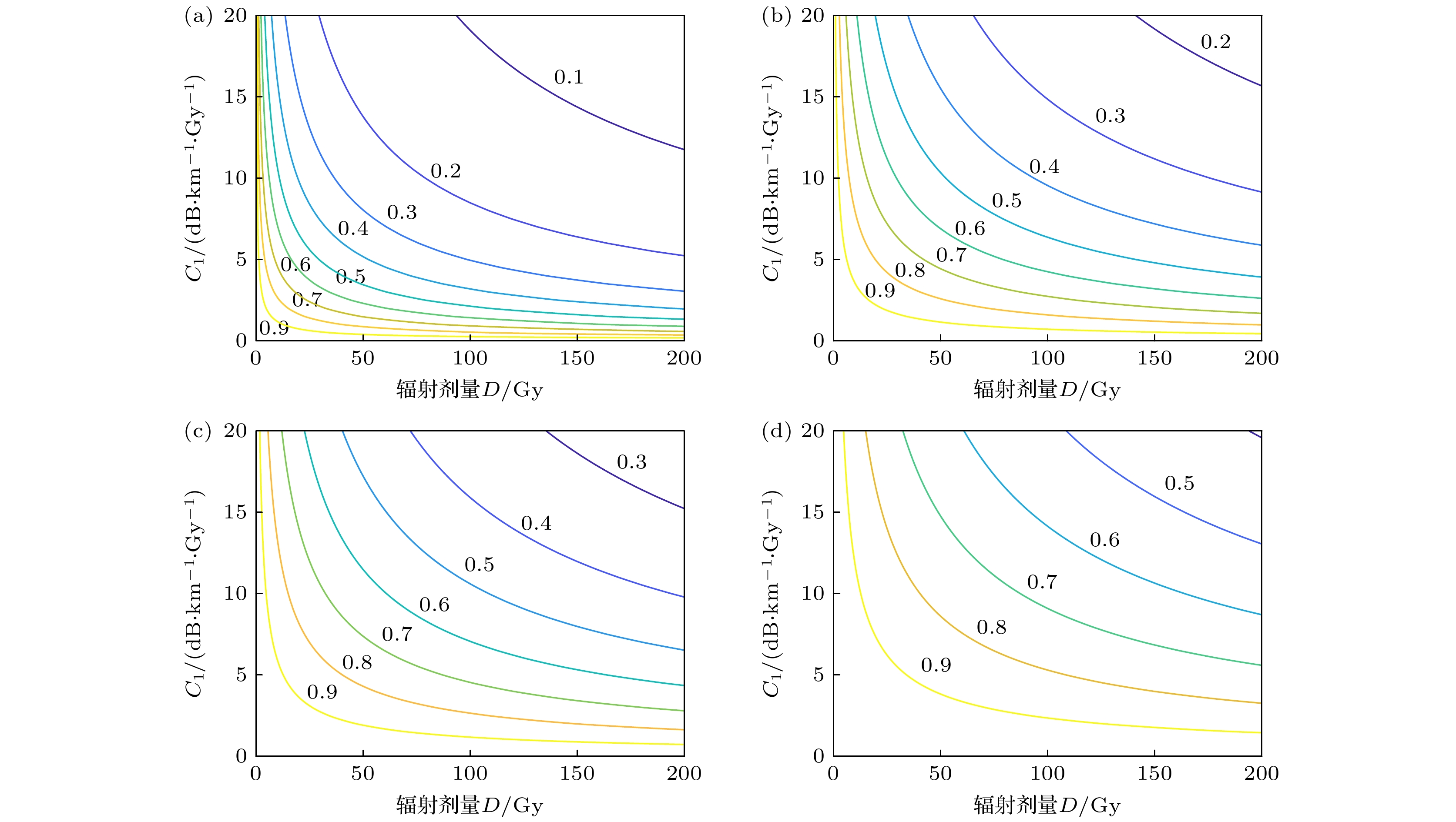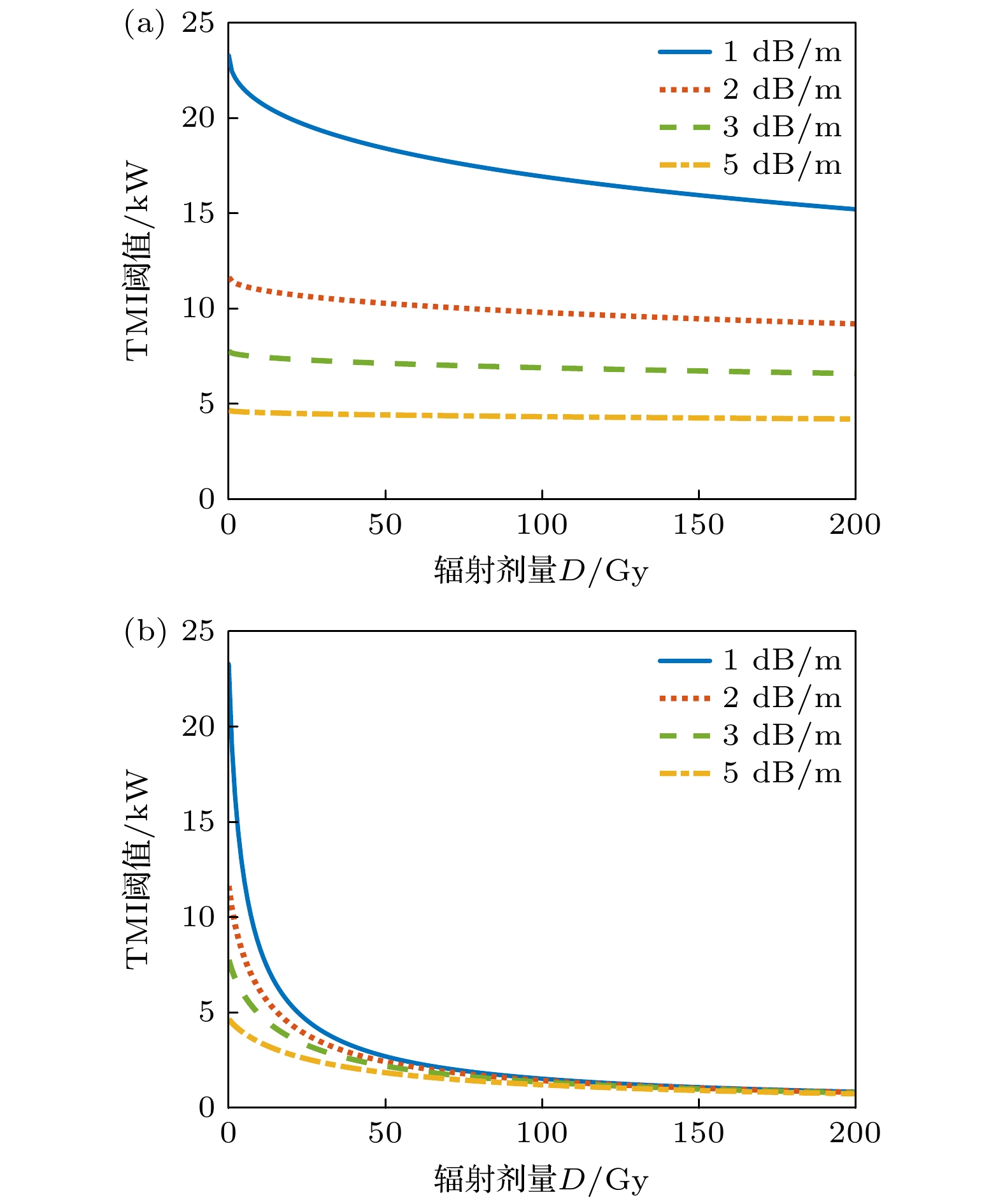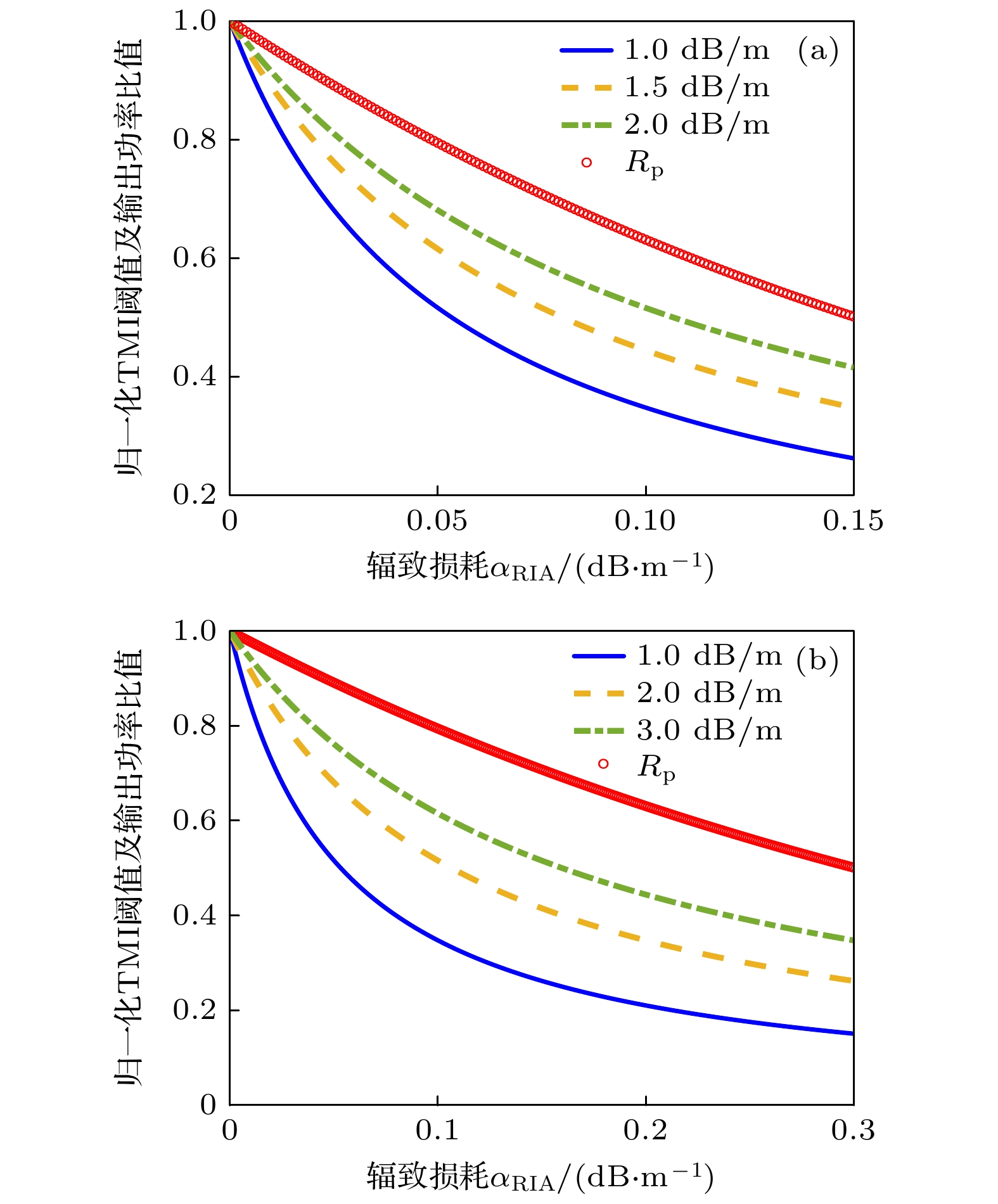-
光纤放大器在辐照环境中具有良好的应用前景, 而模式不稳定(transverse mode instability, TMI)效应则是制约光纤放大器功率提升的重要因素. 因此, 针对辐照效应对于掺镱光纤放大器TMI阈值的影响, 开展了理论研究. 通过将辐致损耗引入光纤放大器的TMI理论模型, 率先给出了考虑辐照效应的TMI阈值表达式, 探讨了TMI阈值随辐射剂量的变化规律, 研究表明: 辐照效应对于TMI阈值的影响, 不仅与光纤的抗辐照性能有关, 还与光纤放大器的增益系数有关. 增益系数的增大, 会减缓TMI阈值随辐射剂量的衰减, 但也会导致TMI阈值的整体下降. 通过对比辐照效应对于TMI阈值和输出功率的影响, 结果发现, TMI阈值随辐致损耗衰减更快. 这也使得TMI效应成为辐照条件下光纤放大器输出功率的限制因素. 相关研究结果, 对于辐射条件下光纤放大器的设计及应用研究具有指导意义.
Yb-doped fiber amplifiers and their applications in radiation environments have become more and more attractive in recent years. However, the radiation effect will cause damage to the Yb-doped fibers, which can give negative effect on the output properties of Yb-doped fiber amplifiers. In this work, the influence of radiation effect on the transverse mode instability (TMI) of Yb-doped fiber amplifier is studied. TMI can couple the single light from the fundamental mode to high-order mode, thereby degenerating the beam quality of fiber amplifier. TMI is considered a key limitation of power up-scaling of fiber amplifiers. In this work, the radiation effect on the TMI is studied theoretically, and a formula of TMI threshold is presented by taking the radiation-induced attenuation (RIA), the most important radiation effect for the TMI, into account. The formula is deduced by introducing the loss of signal light induced by RIA into the formerly reported TMI-threshold formula which can be obtained by the linear stability analysis of the numerical model studying the TMI. Then, the relationship between the TMI and radiation dose is also given with the help of Power-Law describing the relationship between the RIA and radiation dose. With the formula, the variations of TMI threshold with the radiation dose and RIA are studied. It is found, as expected, that the TMI threshold decreases monotonically with the increase of RIA or radiation dose. Nevertheless, it is unexpectedly found that, to some extent, the gain coefficient of fiber amplifiers will also affect the radiation effect on TMI threshold. The results reveal that the increase of gain coefficient will lower the sensitivity of TMI threshold to the radiation dose. However, it is also implied that the gain coefficient cannot be too large because it can also make the TMI threshold lowered. Therefore, in order to maintain a high TMI threshold in a radiation environment, sufficient radiation resistance of Yb-doped fiber is essential. Because the RIA can affect not only the TMI threshold but also the output power or efficiency of Yb-doped fiber amplifier, the comparison between two effects of RIA is also discussed. It is found that the threshold of TMI is more sensitive to the radiation than to the output power or efficiency (see the figure attached below), which means that the TMI can exist in the irradiated Yb-doped fiber amplifier, although the output power is reduced because of RIA. This result can be verified by the experimental observation reported formerly. As a result, TMI can become a key limitation to the output power of Yb-doped fiber amplifier in radiation environments. The relevant results can provide significant guidance for the applications of Yb-doped fiber amplifiers in radiation environments. -
Keywords:
- fiber amplifier /
- radiation effect /
- transverse mode instability /
- radiation-induced attenuation
[1] Girard S, Kuhnhenn J, Gusarov A, Brichard B, Uffelen M V, Ouerdane Y, Boukenter A, Marcandella C 2013 IEEE Trans. Nucl. Sci. 60 2015
 Google Scholar
Google Scholar
[2] Girard S, Morana A, Ladaci A, Robin T, Mescia L, Bonnefois J J, Boutillier M, Mekki J, Paveau A, Cadier B, Marin E, Ouerdane Y, Boukenter A 2018 J. Optics-UK 20 093001
 Google Scholar
Google Scholar
[3] Henschel H, Kohn O, Schmidt H U, Kirchof J, Unger S 1998 IEEE Trans. Nucl. Sci. 45 1552
 Google Scholar
Google Scholar
[4] Rose T S, Gunn D, Valley G C 2001 J. Lightw. Technol. 19 1918
 Google Scholar
Google Scholar
[5] Faustov A V, Gusarov A, Wuilpart M, Fotiadi A A, Liokumovich L B, Zolotovskiy I O, Tomashuk A L, Schoutheete T D, Mégret P 2013 IEEE Trans. Nucl. Sci. 60 2511
 Google Scholar
Google Scholar
[6] Ma J, Li M, Tan L Y, Zhou Y P, Yu S Y, Ran Q W 2009 Opt. Express 17 15571
 Google Scholar
Google Scholar
[7] Girard S, Ouerdane Y, Tortech B, Marcandella C, Robin T, Cadier B, Baggio J, Paillet P, Ferlet-Cavrois V, Boukenter A, Meunier J P, Schwank J R, Shaneyfelt M R, Dodd P E, Blackmore E W 2009 IEEE Trans. Nucl. Sci. 56 3293
 Google Scholar
Google Scholar
[8] Fox B P, Simmons-Potter K, Thomes W J, Kliner D A V 2010 IEEE Trans. Nucl. Sci. 57 1618
 Google Scholar
Google Scholar
[9] Duchez J B, Mady F, Mebrouk Y, Ollier N, Benabdesselam M 2014 Opt. Lett. 39 5969
 Google Scholar
Google Scholar
[10] Xing Y B, Zhao N, Liao L, Wang Y B, Li H Q, Peng J G, Yang L Y, Dai N L, Li J Y 2015 Opt. Express 23 24236
 Google Scholar
Google Scholar
[11] Chen Y S, Xu H Z, Xing Y B, Liao L, Wang Y B, Zhang F F, He X L, Li H Q, Peng J G, Yang L Y, Dai N L, Li J Y 2018 Opt. Express 26 20430
 Google Scholar
Google Scholar
[12] Tao M M, Chen H W, Feng G B, Luan K P, Wang F, Huang K, Ye X S 2020 Opt. Express 28 10104
 Google Scholar
Google Scholar
[13] Tan S, Li Y, Zhang H S, Wang X W, Jin J 2022 Chin. Phys. B 31 064211
 Google Scholar
Google Scholar
[14] Shao C Y, Ren J J, Wang F, Ollier N, Xie F H, Zhang X Y, Zhang L, Yu C L, Hu L L 2018 J. Phys. Chem. B 122 2809
 Google Scholar
Google Scholar
[15] Kher S, Chaubey S, Oak S M, Gusarov A 2013 IEEE Photonic. Technol. Lett. 25 2070
 Google Scholar
Google Scholar
[16] Fernandez A F, Brichard B, Berghmans F 2003 IEEE Photonic. Technol. Lett. 15 1428
 Google Scholar
Google Scholar
[17] Eidam T, Wirth C, Jauregui C, Stutzki F, Jansen F, Otto H-J, Schmidt O, Schreiber T, Limpert J, Tünnermann A 2011 Opt. Express 19 13218
 Google Scholar
Google Scholar
[18] Beier F, Möller F, Sattler B, Nold J, Liem A, Hupel C, Kuhn S, Hein S, Haarlammert N, Schreiber T, Eberhardt R, Tünnermann A 2018 Opt. Lett. 43 1291
 Google Scholar
Google Scholar
[19] Dong L 2013 Opt. Express 21 2642
 Google Scholar
Google Scholar
[20] Tao R M, Wang X L, Zhou P 2018 IEEE J. Sel. Topics in Quant. Elect. 24 0903319
 Google Scholar
Google Scholar
[21] Dong L 2022 J. Lightw. Technol. 40 4795
 Google Scholar
Google Scholar
[22] Xia N, Yoo S 2020 J. Lightw. Technol. 38 4478
 Google Scholar
Google Scholar
[23] Zervas M N 2017 Proc. of SPIE 10083 100830M
 Google Scholar
Google Scholar
[24] Zervas M N 2018 APL Photonic. 4 022802
 Google Scholar
Google Scholar
[25] Zervas M N 2019 Opt. Express 27 19019
 Google Scholar
Google Scholar
[26] Dong L, Ballato J, Kolis J 2023 Opt. Express 31 6690
 Google Scholar
Google Scholar
[27] Cao J Q, Chen M N, Huang Z H, Wang Z F, Chen J B 2024 Opt. Express 32 12892
 Google Scholar
Google Scholar
[28] Kelson I, Hardy A A 1998 IEEE J. Quant. Elect. 34 1570
 Google Scholar
Google Scholar
[29] Jiang Z, Marciante J R 2008 J. Opt. Soc. Am. B 25 247
 Google Scholar
Google Scholar
[30] Richardson D J, Nilsson J, Clarkson W A 2010 J. Opt. Soc. Am. B 27 B63
 Google Scholar
Google Scholar
[31] Snyder A W, Love J D 1983 Optical Waveguide Theory (London: Chapman and Hall) pp254-255
[32] Huang Z M, Shu Q, Luo Y, Tao R M, Feng X, Liu Y, Lin H H, Wang J J, Jing F 2021 J. Opt. Soc. Am. B 38 2945
 Google Scholar
Google Scholar
[33] Lezius M, Predehl K, Stower W, Turler A, Greiter M, Hoeschen C, Thirolf P, Assmann W, Habs D, Prokofiev A, Ekstrom C, Hansch T W, Holzwarth R 2012 IEEE Trans. Nucl. Sci. 59 425
 Google Scholar
Google Scholar
[34] 黄宏琪, 赵楠, 陈瑰, 廖雷, 刘自军, 彭景刚, 戴能利 2014 63 200201
Huang H Q, Zhao N, Chen G, Liao L, Liu Z J, Peng J G, Dai N L 2014 Acta Phys. Sin. 63 200201
[35] Fox B P, Schneider Z V, Simmons-Potter K, Thomes W J, Meister D C, Bambha R P, Kliner D A V 2008 IEEE J. Quant. Elect. 44 581
 Google Scholar
Google Scholar
[36] Fox B P, Simmons-Potter K, Thomes W J, Meister D C, Bambha R P, Kliner D A V 2008 Proc. of SPIE 7095 70950B
[37] Hecht J 2009 Laser Focus World 45 53
[38] Wang Y S, Peng W J, Liu H, Yang X B, Yu H M, Wang Y, Wang J, Feng Y J, Sun Y H, Ma Y, Gao Q S, Tang C 2023 Opt. Lett. 48 2909
 Google Scholar
Google Scholar
-
图 1 归一化TMI阈值随辐射剂量D、系数C1和f的变化, 泵浦光和信号光波长分别为976 nm和1080 nm, 增益系数gsat为2 dB/m, f取值分别为0.5 (a), 0.7 (b), 0.9 (c), 1.1 (d)
Fig. 1. Variation of normalized TMI threshold with radiation dose D, coefficients C1 and f, the pump wavelength and signal wavelength are 976 nm and 1080 nm, respectively, and the gain coefficient gsat is 2 dB/m. The value of coefficient f are 0.5 (a), 0.7 (b), 0.9 (c), and 1.1 (d), respectively.
图 2 归一化TMI阈值随辐射剂量D、系数C1和f的变化, 泵浦光和信号光波长分别为976 nm和1080 nm, 系数f为0.7, 增益系数取值分别为1 dB/m (a), 3 dB/m (b), 5 dB/m (c), 10 dB/m (d)
Fig. 2. Variation of normalized TMI threshold with radiation dose D, coefficients C1 and f. The pump wavelength and signal wavelength are 976 nm and 1080 nm respectively, and the coefficient f is 0.7. The value of gain coefficient are 1 dB/m (a), 3 dB/m (b), 5 dB/m (c), and 10 dB/m (d), respectively.
-
[1] Girard S, Kuhnhenn J, Gusarov A, Brichard B, Uffelen M V, Ouerdane Y, Boukenter A, Marcandella C 2013 IEEE Trans. Nucl. Sci. 60 2015
 Google Scholar
Google Scholar
[2] Girard S, Morana A, Ladaci A, Robin T, Mescia L, Bonnefois J J, Boutillier M, Mekki J, Paveau A, Cadier B, Marin E, Ouerdane Y, Boukenter A 2018 J. Optics-UK 20 093001
 Google Scholar
Google Scholar
[3] Henschel H, Kohn O, Schmidt H U, Kirchof J, Unger S 1998 IEEE Trans. Nucl. Sci. 45 1552
 Google Scholar
Google Scholar
[4] Rose T S, Gunn D, Valley G C 2001 J. Lightw. Technol. 19 1918
 Google Scholar
Google Scholar
[5] Faustov A V, Gusarov A, Wuilpart M, Fotiadi A A, Liokumovich L B, Zolotovskiy I O, Tomashuk A L, Schoutheete T D, Mégret P 2013 IEEE Trans. Nucl. Sci. 60 2511
 Google Scholar
Google Scholar
[6] Ma J, Li M, Tan L Y, Zhou Y P, Yu S Y, Ran Q W 2009 Opt. Express 17 15571
 Google Scholar
Google Scholar
[7] Girard S, Ouerdane Y, Tortech B, Marcandella C, Robin T, Cadier B, Baggio J, Paillet P, Ferlet-Cavrois V, Boukenter A, Meunier J P, Schwank J R, Shaneyfelt M R, Dodd P E, Blackmore E W 2009 IEEE Trans. Nucl. Sci. 56 3293
 Google Scholar
Google Scholar
[8] Fox B P, Simmons-Potter K, Thomes W J, Kliner D A V 2010 IEEE Trans. Nucl. Sci. 57 1618
 Google Scholar
Google Scholar
[9] Duchez J B, Mady F, Mebrouk Y, Ollier N, Benabdesselam M 2014 Opt. Lett. 39 5969
 Google Scholar
Google Scholar
[10] Xing Y B, Zhao N, Liao L, Wang Y B, Li H Q, Peng J G, Yang L Y, Dai N L, Li J Y 2015 Opt. Express 23 24236
 Google Scholar
Google Scholar
[11] Chen Y S, Xu H Z, Xing Y B, Liao L, Wang Y B, Zhang F F, He X L, Li H Q, Peng J G, Yang L Y, Dai N L, Li J Y 2018 Opt. Express 26 20430
 Google Scholar
Google Scholar
[12] Tao M M, Chen H W, Feng G B, Luan K P, Wang F, Huang K, Ye X S 2020 Opt. Express 28 10104
 Google Scholar
Google Scholar
[13] Tan S, Li Y, Zhang H S, Wang X W, Jin J 2022 Chin. Phys. B 31 064211
 Google Scholar
Google Scholar
[14] Shao C Y, Ren J J, Wang F, Ollier N, Xie F H, Zhang X Y, Zhang L, Yu C L, Hu L L 2018 J. Phys. Chem. B 122 2809
 Google Scholar
Google Scholar
[15] Kher S, Chaubey S, Oak S M, Gusarov A 2013 IEEE Photonic. Technol. Lett. 25 2070
 Google Scholar
Google Scholar
[16] Fernandez A F, Brichard B, Berghmans F 2003 IEEE Photonic. Technol. Lett. 15 1428
 Google Scholar
Google Scholar
[17] Eidam T, Wirth C, Jauregui C, Stutzki F, Jansen F, Otto H-J, Schmidt O, Schreiber T, Limpert J, Tünnermann A 2011 Opt. Express 19 13218
 Google Scholar
Google Scholar
[18] Beier F, Möller F, Sattler B, Nold J, Liem A, Hupel C, Kuhn S, Hein S, Haarlammert N, Schreiber T, Eberhardt R, Tünnermann A 2018 Opt. Lett. 43 1291
 Google Scholar
Google Scholar
[19] Dong L 2013 Opt. Express 21 2642
 Google Scholar
Google Scholar
[20] Tao R M, Wang X L, Zhou P 2018 IEEE J. Sel. Topics in Quant. Elect. 24 0903319
 Google Scholar
Google Scholar
[21] Dong L 2022 J. Lightw. Technol. 40 4795
 Google Scholar
Google Scholar
[22] Xia N, Yoo S 2020 J. Lightw. Technol. 38 4478
 Google Scholar
Google Scholar
[23] Zervas M N 2017 Proc. of SPIE 10083 100830M
 Google Scholar
Google Scholar
[24] Zervas M N 2018 APL Photonic. 4 022802
 Google Scholar
Google Scholar
[25] Zervas M N 2019 Opt. Express 27 19019
 Google Scholar
Google Scholar
[26] Dong L, Ballato J, Kolis J 2023 Opt. Express 31 6690
 Google Scholar
Google Scholar
[27] Cao J Q, Chen M N, Huang Z H, Wang Z F, Chen J B 2024 Opt. Express 32 12892
 Google Scholar
Google Scholar
[28] Kelson I, Hardy A A 1998 IEEE J. Quant. Elect. 34 1570
 Google Scholar
Google Scholar
[29] Jiang Z, Marciante J R 2008 J. Opt. Soc. Am. B 25 247
 Google Scholar
Google Scholar
[30] Richardson D J, Nilsson J, Clarkson W A 2010 J. Opt. Soc. Am. B 27 B63
 Google Scholar
Google Scholar
[31] Snyder A W, Love J D 1983 Optical Waveguide Theory (London: Chapman and Hall) pp254-255
[32] Huang Z M, Shu Q, Luo Y, Tao R M, Feng X, Liu Y, Lin H H, Wang J J, Jing F 2021 J. Opt. Soc. Am. B 38 2945
 Google Scholar
Google Scholar
[33] Lezius M, Predehl K, Stower W, Turler A, Greiter M, Hoeschen C, Thirolf P, Assmann W, Habs D, Prokofiev A, Ekstrom C, Hansch T W, Holzwarth R 2012 IEEE Trans. Nucl. Sci. 59 425
 Google Scholar
Google Scholar
[34] 黄宏琪, 赵楠, 陈瑰, 廖雷, 刘自军, 彭景刚, 戴能利 2014 63 200201
Huang H Q, Zhao N, Chen G, Liao L, Liu Z J, Peng J G, Dai N L 2014 Acta Phys. Sin. 63 200201
[35] Fox B P, Schneider Z V, Simmons-Potter K, Thomes W J, Meister D C, Bambha R P, Kliner D A V 2008 IEEE J. Quant. Elect. 44 581
 Google Scholar
Google Scholar
[36] Fox B P, Simmons-Potter K, Thomes W J, Meister D C, Bambha R P, Kliner D A V 2008 Proc. of SPIE 7095 70950B
[37] Hecht J 2009 Laser Focus World 45 53
[38] Wang Y S, Peng W J, Liu H, Yang X B, Yu H M, Wang Y, Wang J, Feng Y J, Sun Y H, Ma Y, Gao Q S, Tang C 2023 Opt. Lett. 48 2909
 Google Scholar
Google Scholar
计量
- 文章访问数: 3150
- PDF下载量: 84
- 被引次数: 0













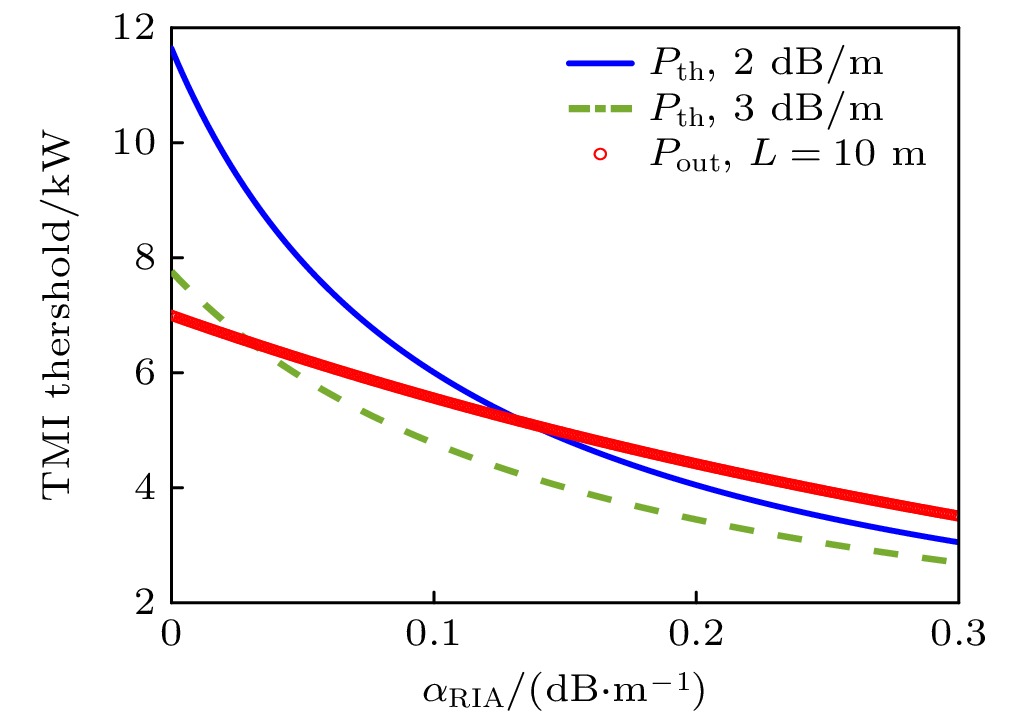
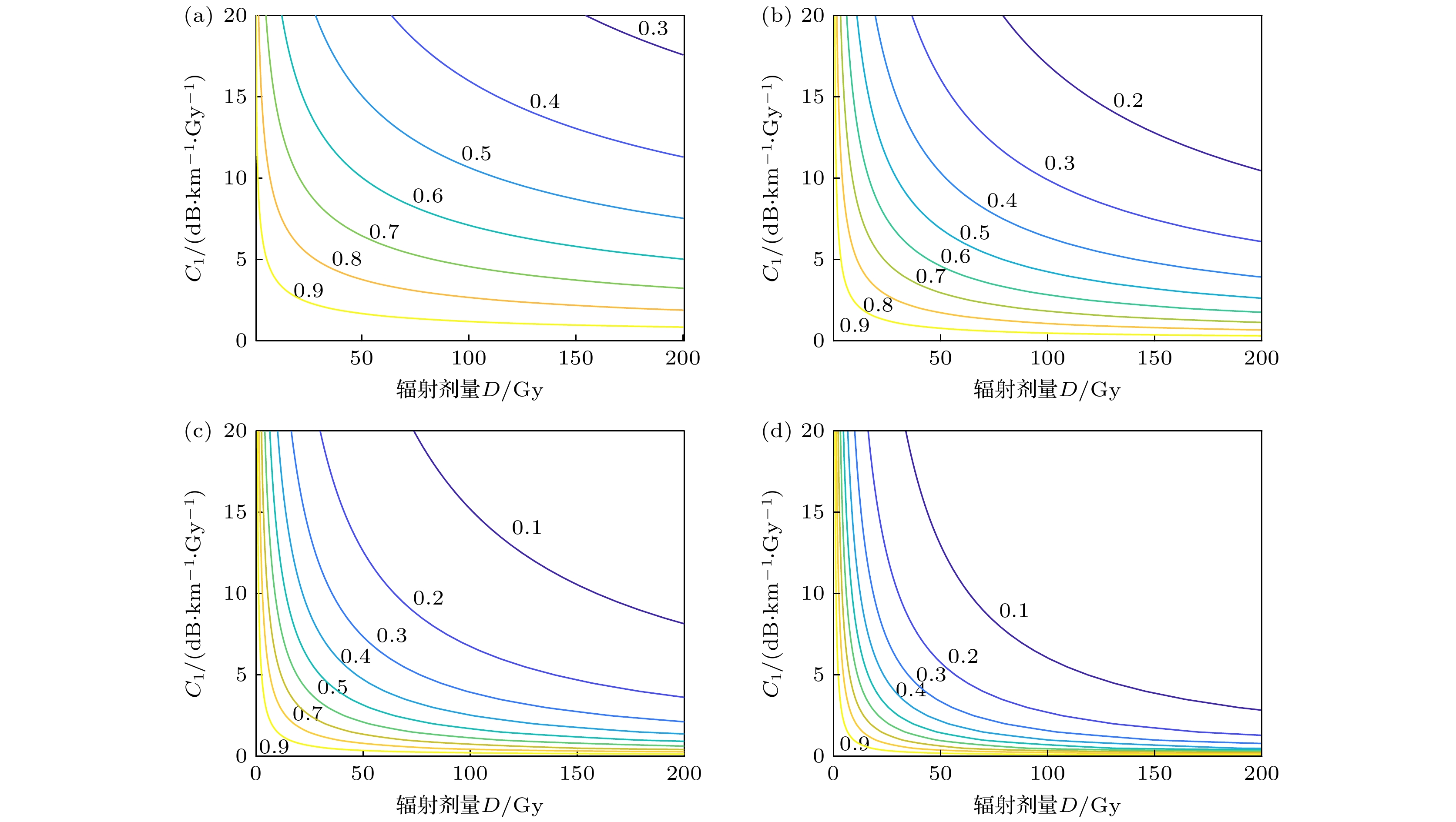
 下载:
下载:
